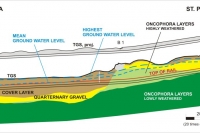New Vienna - St. Pölten Railway Line
Client: Austrian Railways Infrastructure AG
Development Period: 1991 to 2012
The 42 km long, double tracked high performance railway line starts from the project Lainz Tunnel with the Wienerwald Tunnel (length 13 km). The overburden varies and reaches a maximum of 240 m. After the western portal, the route crosses the southern Tulln flood plain on mostly low embankments until the village of Atzenbrugg. Subsequently, the project is situated in the Perschling valley plain; and thereafter at the foot of the southern valley slope. In this section, three tunnels were built by the cut-and-cover method, in addition to short cuts and embankments. Until the end of the project at Pottenbrunn, three more tunnels, established by the mining technique, are situated (total length 7,4 km).
BGG was involved as an expert in all matters of geotechnics and geohydrology since the beginning of the route selection phase. Given that it was one of the first Austrian projects with an environmental impact procedure, pioneering work had to be done. In close cooperation with the other members of the planning team, the possible routes were evaluated, compared and optimized with regard to location and level. As a result, the environmental impact statement was composed, forming the basis of the route decree and the subsequent procedure of the building permission.
From the beginning, a consensus was sought with the communities, citizens' groups and neighbours, which resulted finally in a favourable project variant for all parties. From 2003 to 2012, the construction was in progress along the complete line. Up to three tunnel boring machines (TBM) were in use simultaneously.
Atzenbrugg Tunnel:
From a geohydrological point of view, the section where the selected route (variant 2/2a) crosses the Perschling valley plain at Atzenbrugg and the high-lying terrasse at Michelndorf was especially scrutinized by the planning team, the communities and the citizens, right from the start of the project.
In this section, the tunnel structure cuts into the ground water body and is also integrated in the aquitard. In this regard, it had to be dealt with the question of the effectivity of ground water exchange measures and an environmentally friendly construction process. In order to prevent a significant impact on the ground water regime, the construction was established in sections and a water-tight construction pit was carried out. For the final state, comprehensive ground water exchange measures were implemented.
April 2006
